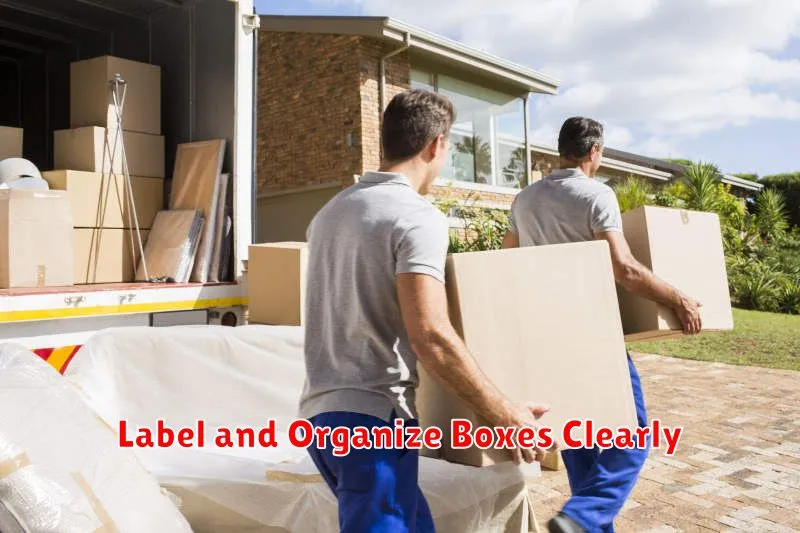Moving into a new home can be an exciting yet stressful experience. From packing and transporting belongings to handling logistics and settling into a new environment, there are numerous details to manage. However, with careful planning and execution, you can ensure a smooth and efficient move. This comprehensive guide provides valuable tips for moving into a new home, covering every aspect of the process, from pre-planning and packing to unpacking and settling in. Whether you’re a first-time homebuyer or a seasoned mover, these tips will help you navigate the transition with ease and minimize potential challenges.
Learn how to pack efficiently, protect your belongings, and organize your move for a stress-free experience. We’ll cover key aspects such as creating a moving checklist, decluttering before you pack, choosing the right packing supplies, and labeling boxes strategically. Explore tips for moving into a new home smoothly, including how to manage utilities, change your address, and handle important documentation. We’ll also discuss strategies for unpacking efficiently and organizing your new space, so you can quickly feel settled and at home.
Create a Moving Timeline and Checklist
A moving timeline, also known as a rolling timeline or dynamic timeline, offers flexibility for projects with evolving deadlines. It’s crucial to establish a clear starting point and define the overall project duration. Instead of fixed dates, utilize time blocks or phases. For instance, “Phase 1: Research (2 weeks)” allows for adjustments as the project progresses. Regularly update the timeline to reflect changes and ensure it remains a relevant project management tool.
Integrating a checklist with your moving timeline enhances organization and progress tracking. Assign checklist items to each phase or time block. This provides a granular view of tasks required for completion. As the timeline shifts, the checklist items move along with it, maintaining alignment between schedule and actionable steps. Mark completed checklist items to visualize progress and identify potential roadblocks.
Effective implementation requires consistent review and communication. Regularly review the timeline and checklist with stakeholders to ensure everyone is aware of the current status and any adjustments. Open communication facilitates proactive problem-solving and maintains momentum throughout the project lifecycle.
Declutter Before Packing
Decluttering before packing is a crucial step for a smoother and more efficient move. By eliminating unnecessary items, you’ll significantly reduce the amount of packing materials needed, lower transportation costs, and make unpacking in your new space a breeze. Start by sorting belongings into categories: keep, donate, sell, and discard. Be honest with yourself about what you truly need and use. This process not only lightens your physical load but also reduces the mental burden of dealing with excess possessions.
Implementing a systematic approach to decluttering can make the task less overwhelming. Begin by tackling one room or even a single drawer at a time. Consider using the “four-box method” described above or a similar strategy to guide your decision-making process. For items you’re unsure about, try the “one year rule”: if you haven’t used it in the past year, it’s likely you won’t miss it. Remember to dispose of unwanted items responsibly by recycling or donating whenever possible.
Decluttering offers several benefits beyond simply reducing the volume of items to pack. It provides an opportunity to rediscover forgotten treasures, re-evaluate your attachment to material possessions, and create a more organized and streamlined lifestyle in your new home. Taking the time to declutter before you pack can significantly improve your overall moving experience.
Hiring Movers vs. DIY Move

Deciding between hiring professional movers and conducting a do-it-yourself move involves weighing several key factors. Hiring movers offers significant advantages in terms of convenience and reduced physical strain. Movers handle the packing, loading, transportation, and unloading of your belongings, saving you time and effort. This is particularly beneficial for those with large households, heavy furniture, or physical limitations. However, professional moving services come at a cost, which can be substantial depending on the distance and volume of items being moved.
A DIY move, on the other hand, offers greater control over the process and significant cost savings. You have complete oversight of how your belongings are packed and handled. This option can be appealing for those on a tight budget, individuals with smaller moves, or those who prefer a hands-on approach. However, a DIY move requires significant time commitment, physical exertion, and the logistics of renting a truck and potentially recruiting help from friends or family. Damage to belongings during transit is also a greater risk.
Ultimately, the best choice depends on your individual circumstances and priorities. Carefully assess the size and complexity of your move, your budget, and the value of your time and physical well-being when making your decision.
Label and Organize Boxes Clearly

Clear labeling and organization are crucial for efficient moving and storage. Use a permanent marker to write the contents of each box on its sides, not just the top. This allows for easy identification even when boxes are stacked. Be as specific as possible when listing contents; “Kitchen Utensils” is better than “Kitchen,” and “Pots and Pans” is even more helpful. Consider numbering boxes and creating a corresponding master list detailing the contents of each numbered box. This provides a comprehensive inventory and aids in locating specific items quickly.
Strategic packing and labeling further enhance organization. Pack items from the same room together and label boxes accordingly (e.g., “Bedroom – Linens,” “Bathroom – Toiletries”). For fragile items, clearly mark boxes with “Fragile” or “Handle with Care.” Indicate which side of the box should be kept upright with “This Side Up” arrows. This extra effort helps movers understand the contents and handle boxes appropriately, minimizing the risk of damage.
Implementing a consistent labeling system streamlines the unpacking process. Use color-coded labels or markers to designate boxes for different rooms, making it easy to sort boxes upon arrival. This saves significant time and effort, especially in larger moves. Consider adding a priority label for boxes containing essential items needed immediately upon arrival, such as toiletries, medications, or basic kitchen supplies. This allows for quick access to essential items without having to sift through numerous boxes.
Set Up Utilities in Advance

Moving can be stressful, but setting up your utilities beforehand can alleviate some of that burden. Contact the utility companies for your new place at least two weeks before your move-in date. This includes electricity, gas, water, internet, and trash/recycling services. Having these essentials ready to go when you arrive will make settling in much smoother.
Provide the companies with your new address, requested start date, and any necessary account information. Confirm the connection fees and any required deposits. Some companies may offer online setup, which can expedite the process. Keeping a record of your confirmation numbers and contact information is also highly recommended. This will be helpful if any issues arise during the setup process.
Consider setting up mail forwarding with the post office to ensure you receive important documents during the transition. Also, research any specific utility requirements or procedures for your new location. For instance, some areas may have different providers or regulations for certain services.
Inspect the New Home Upon Arrival
Before settling into your new home, it’s crucial to conduct a thorough inspection. This is your opportunity to identify any discrepancies between the agreed-upon condition and the current state of the property. Check for any damage that may have occurred during the moving process, such as scratches on walls or floors. Document everything with photos or videos and immediately report any issues to the relevant parties, whether that’s the seller, landlord, or moving company.
Pay close attention to the essential utilities and systems. Ensure that the water, electricity, and gas are functioning correctly. Test all appliances, including the oven, refrigerator, dishwasher, and washing machine. Check the plumbing for leaks and ensure that the heating and cooling systems are working as expected. Verify that all included fixtures and features, as listed in your agreement, are present and in working order.
Finally, review your move-in checklist and confirm that everything you agreed upon is accounted for. This includes items like keys, garage door openers, and any appliances or fixtures specified in your contract. This is your chance to address any discrepancies and ensure your new home meets your expectations before you fully unpack and settle in.
Make It Feel Like Home Quickly
Moving into a new space can feel daunting, but a few key actions can quickly transform it into a comfortable haven. First, unpack essentials immediately. Focus on the bedroom and bathroom to establish a sense of normalcy. Setting up your bed, putting out toiletries, and hanging a few towels makes a big difference. Then, prioritize the kitchen by unpacking essential cookware and stocking the pantry with your favorite staples. These simple steps create a functional foundation for daily life.
Next, personalize your space. Decorate with familiar items that evoke a sense of comfort and belonging. Hang cherished artwork, display family photos, and arrange treasured books. Adding soft furnishings, such as throw pillows and blankets, creates a cozy atmosphere. A familiar scent, whether from a favorite candle or diffuser, can also significantly impact how quickly a new place feels like home.
Finally, explore your new surroundings. Familiarize yourself with the neighborhood by taking walks, visiting local shops, and discovering nearby parks. Connecting with your new community helps establish a sense of place and belonging. This will accelerate the transition and make your new house feel like home in no time.

